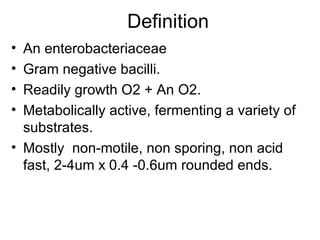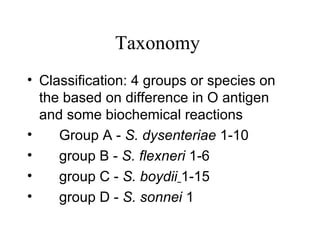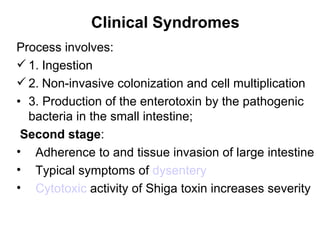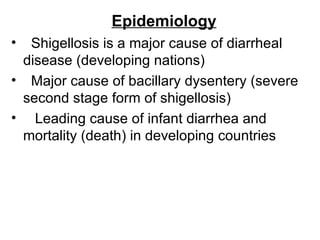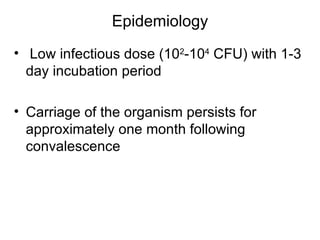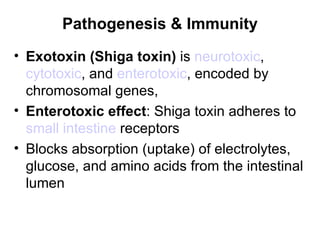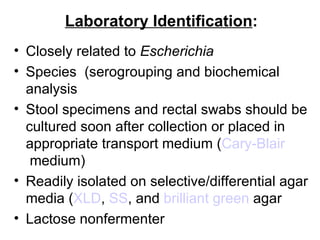Shigella
- 1. Shigella Dr Sabrina Moyo Department of Microbiology and Immunology
- 2. Definition An enterobacteriaceae Gram negative bacilli. Readily growth O2 + An O2. Metabolically active, fermenting a variety of substrates. Mostly non-motile, non sporing, non acid fast, 2-4um x 0.4 -0.6um rounded ends.
- 3. Morphology & Physiology Small Gram-negative, facultatively anaerobic, coliform bacillus Non-motile (no H antigen) Possess capsule (K antigen) and O antigen K antigen not useful in serologic typing, but can interfere with O antigen determination O antigens : A, B, C, D correspond respectively to the four species Non-lactose fermenting Bile salts resistant: trait useful for selective media ferment glucose reduce nitrates (NO 3 to NO 2 or N 2 ) are oxidase negative
- 4. Taxonomy Family Enterobacteriaceae Shigella dysenteriae : most serious form of bacillary dysentery Shigella flexneri : shigellosis in underdeveloped countries Shigella sonnei : shigellosis in developed countries Shigella boydii
- 5. Taxonomy Classification: 4 groups or species on the based on difference in O antigen and some biochemical reactions Group A - S. dysenteriae 1-10 group B - S. flexneri 1-6 group C - S. boydii 1-15 group D - S. sonnei 1
- 6. Clinical Syndromes (Shigellosis) Ranges from asymptomatic infection to severe bacillary dysentery Two-stage disease: watery diarrhea changing to dysentery with frequent small stools with blood and mucus, tenesmus , cramps, fever Early stage : Watery diarrhea attributed to the enterotoxic activity of Shiga toxin Fever attributed to neurotoxic activity of toxin
- 7. Clinical Syndromes Process involves: 1. Ingestion 2. Non-invasive colonization and cell multiplication 3. Production of the enterotoxin by the pathogenic bacteria in the small intestine; Second stage : Adherence to and tissue invasion of large intestine Typical symptoms of dysentery Cytotoxic activity of Shiga toxin increases severity
- 8. Epidemiology Shigellosis is a major cause of diarrheal disease (developing nations) Major cause of bacillary dysentery (severe second stage form of shigellosis) Leading cause of infant diarrhea and mortality (death) in developing countries
- 9. Epidemiology Shigella occurs naturally in higher primates Spread from human to human via the fecal-oral route Less frequently, transmission by ingestion of contaminated food or water Outbreaks usually occur in close communities; Secondary transmission occurs frequently
- 10. Epidemiology Low infectious dose (10 2 -10 4 CFU) with 1-3 day incubation period Carriage of the organism persists for approximately one month following convalescence
- 11. Pathogenesis & Immunity Invasiveness involves attachment (adherence) and internalization Controlled by a multi-gene virulence plasmid Organisms penetrate through colonic mucosa invade and multiply in the colonic epithelium Not beyond the epithelium into the lamina propria
- 12. Pathogenesis & Immunity Bacterial cells preferentially attach to and invade into M cells in Peyer's patches of small intestine M cells typically transport foreign antigens from the intestine to underlying macrophages, Shigella can lyse the phagocytic vacuole (phagosome) and replicate in the cytoplasm
- 13. Pathogenesis & Immunity Exotoxin (Shiga toxin) is neurotoxic , cytotoxic , and enterotoxic , encoded by chromosomal genes, Enterotoxic effect : Shiga toxin adheres to small intestine receptors Blocks absorption (uptake) of electrolytes, glucose, and amino acids from the intestinal lumen
- 14. Pathogenesis & Immunity Cytotoxic effect: B subunit of Shiga toxin binds host cell glycolipid in large intestine , Inactivate the 60S ribosomal subunit, Inhibit protein synthesis, causing cell death, microvasculature damage to the intestine, and hemorrhage (blood and fecal leukocytes in stool) Neurotoxic effect: Fever, abdominal cramping are considered signs of neurotoxicity
- 15. Laboratory Identification : Closely related to Escherichia Species (serogrouping and biochemical analysis Stool specimens and rectal swabs should be cultured soon after collection or placed in appropriate transport medium ( Cary-Blair medium) Readily isolated on selective/differential agar media ( XLD , SS , and brilliant green agar Lactose nonfermenter
- 16. Treatment, Prevention & Control : Dehydration is problem to attend Treat carriers, major source of organisms; Cirpflxacin , Erythromycin Antibiotic resistance is a major problem Proper sewage disposal and water chlorination Oral vaccines of Shigella : E. coli hybrids or Shigella mutants offers immunity for six months to one year
- 17. THANK YOU!


